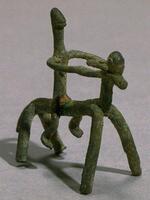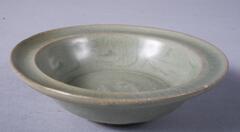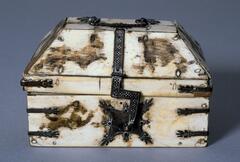12 UMMA Objects
12 UMMA Objects
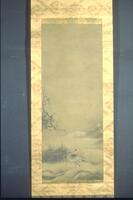
Chinese (Chinese (culture or style))
Herdboy and Buffalo in the Moonlight
1200 – 1399
Museum purchase made possible by the Margaret Watson Parker Art Collection Fund
1961/2.12
![A yellow brownish glaze is applied and crackling covers the entire body.<br />
This bowl has straight wall. The exterior is carved with lotus petals. The below of the mouth is decorated with fret design. The foot is a little low.
<p>This is a cylindrical cup decorated with incised and raised design of lotus petals on the entire outer walls and is fretted on the outer rim. Overall, the cup is yellow-green in color and has three refractory spur marks. Many of the shards, excavated from sediment in the vicinity of Kiln no. 12 at Yucheon-ri, Buan-gun, Jeollabuk-do, are also those of cylindrical cups similar in form to this one.<br />
[<em>Korean Collection, University of Michigan Museum of Art </em>(2014) p.123]<br />
</p>
A yellow brownish glaze is applied and crackling covers the entire body.<br />
This bowl has straight wall. The exterior is carved with lotus petals. The below of the mouth is decorated with fret design. The foot is a little low.
<p>This is a cylindrical cup decorated with incised and raised design of lotus petals on the entire outer walls and is fretted on the outer rim. Overall, the cup is yellow-green in color and has three refractory spur marks. Many of the shards, excavated from sediment in the vicinity of Kiln no. 12 at Yucheon-ri, Buan-gun, Jeollabuk-do, are also those of cylindrical cups similar in form to this one.<br />
[<em>Korean Collection, University of Michigan Museum of Art </em>(2014) p.123]<br />
</p>](/media/W1siZiIsIjIwMjIvMDkvMjQvNWU0NDFuZ3Nuc19kZWZhdWx0LmpwZyJdLFsicCIsInRodW1iIiwiMjQweDIwMCJdXQ?sha=243d2e8e37f3b830)
Korean (Korean (culture or style))
Deep bowl with vertical sides and carved lotus petal design
1200 – 1399
Gift of Bruce and Inta Hasenkamp and Museum purchase made possible by Elder and Mrs. Sang-Yong Nam
2004/1.228
![<p>This cup is similar in appearance to a round pot, with its mouth curving inwards slightly. The glaze has been oxidized, producing brown tints. The outer rim is black inlaid with a fret-patterned band, below which is also inlaid in black with chrysanthemum spray designs in three places. Coarse sand is stuck on the entire foot and outer base. Glaze has owed down to the interior of the cup during ring and has severely peeled off from the mouth and the outer surface in parts, exposing the body.<br />
[<em>Korean Collection, University of Michigan Museum of Art</em> (2014) p.123]<br />
</p>
<p>This cup is similar in appearance to a round pot, with its mouth curving inwards slightly. The glaze has been oxidized, producing brown tints. The outer rim is black inlaid with a fret-patterned band, below which is also inlaid in black with chrysanthemum spray designs in three places. Coarse sand is stuck on the entire foot and outer base. Glaze has owed down to the interior of the cup during ring and has severely peeled off from the mouth and the outer surface in parts, exposing the body.<br />
[<em>Korean Collection, University of Michigan Museum of Art</em> (2014) p.123]<br />
</p>](/media/W1siZiIsIjIwMjIvMDkvMjQvOG9sZTg1M2QydV9kZWZhdWx0LmpwZyJdLFsicCIsInRodW1iIiwiMjQweDIwMCJdXQ?sha=459b8b86f161841d)
Korean (Korean (culture or style))
Small Cup
1200 – 1399
Gift of Bruce and Inta Hasenkamp and Museum purchase made possible by Elder and Mrs. Sang-Yong Nam
2004/1.251

Indian (Indian (South Asian))
Durga on her lion mount
1200 – 1399
Gift of Dr. and Mrs. Leo S. Figiel and Dr. and Mrs. Steven J. Figiel
1981/1.315
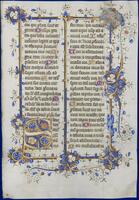
French (French (culture or style))
Leaf from a Psalter
1200 – 1399
Gift of Mrs. Carrol Robertsen
2015/2.3A&B

Syrian
Bottle
1200 – 1399
Museum purchase made possible by the Margaret Watson Parker Art Collection Fund
1961/1.189

Syrian
Bird
1200 – 1399
Museum purchase made possible by the Margaret Watson Parker Art Collection Fund
1961/1.190
![<p>This is an undecorated bowl with diagonally flaring out sides. On the outer base and rim of the foot remain traces of refractory spur marks. The bowl was oxidized in the kiln, producing a green-brown hue, while the interior contains large bubbles. The color of its glaze is similar to that of other vessels excavated from sedimentary layers of refuse pile at celadon kilns in Goyang-si, Gyeonggi-do.<br />
[<em>Korean Collection, University of Michigan Museum of Art </em>(2014) p.101]</p>
<br />
It has an outwardly flared rim and steep side. A yellow brownish glaze is applied. The clay contains some impurities and the foot is relatively high. There is four spur-marks on the interior. <p>This is an undecorated bowl with diagonally flaring out sides. On the outer base and rim of the foot remain traces of refractory spur marks. The bowl was oxidized in the kiln, producing a green-brown hue, while the interior contains large bubbles. The color of its glaze is similar to that of other vessels excavated from sedimentary layers of refuse pile at celadon kilns in Goyang-si, Gyeonggi-do.<br />
[<em>Korean Collection, University of Michigan Museum of Art </em>(2014) p.101]</p>
<br />
It has an outwardly flared rim and steep side. A yellow brownish glaze is applied. The clay contains some impurities and the foot is relatively high. There is four spur-marks on the interior.](/media/W1siZiIsIjIwMjIvMDUvMjUvMnhtbDducjBocl9kZWZhdWx0LmpwZyJdLFsicCIsInRodW1iIiwiMjQweDIwMCJdXQ?sha=ab0ce1dba1be4d21)
Korean (Korean (culture or style))
Bowl with spreading, sloping sides
1200 – 1399
Gift of Toshiko Ogita in memory of Tomoo Ogita
1987/1.303
Loading…
